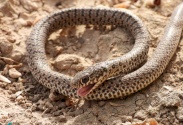Large whip snake
© All rights reserved by www.mahmiyat.ps
The large whip snake belongs to the Colubridae family in the Squamata order (suborder Ophidia). A very common non-venomous snake, one of many belonging to the Colubridae family that are present in Palestine. Its length can reach up to 2.5 m. A diurnal agile snake. The adults are black beside the bottom of the head, which is white or grey. Young whose length is less than 1.2 m are brown or gray and have random dark dots on their back. As they mature, they gradually change the color to black. The head scales are larger than the body scales. The mating is during spring, up to 14 eggs are laid between June and August and hatching occurs 2 months later. During the mating season, the combat between males can be mistaken as courting. The diet consists of rodents, birds and reptiles (lizards and other snakes). Found in a variety of Mediterranean habitats such as fields, woods and even sands. It can be found next to agricultural settlements. Farmers consider this snake as a biological pest controller because of its size and ability to consume rodents. It inhibits Mediterranean countries, Turkey and Greece. Conservation status: Least Concern. In Palestine: It can be found in Mediterranean habitats. The large whip snake belongs to the Colubridae family in the Squamata order (suborder Ophidia). A very common non-venomous snake, one of many belonging to the Colubridae family that are present in Palestine. Its length can reach up to 2.5 m. A diurnal agile snake. The adults are black beside the bottom of the head, which is white or grey. Young whose length is less than 1.2 m are brown or gray and have random dark dots on their back. As they mature, they gradually change the color to black. The head scales are larger than the body scales. The mating is during spring, up to 14 eggs are laid between June and August and hatching occurs 2 months later. During the mating season, the combat between males can be mistaken as courting. The diet consists of rodents, birds and reptiles (lizards and other snakes). Found in a variety of Mediterranean habitats such as fields, woods and even sands. It can be found next to agricultural settlements. Farmers consider this snake as a biological pest controller because of its size and ability to consume rodents. It inhibits Mediterranean countries, Turkey and Greece.
Conservation status: Least Concern. In Palestine: It can be found in Mediterranean habitats.



